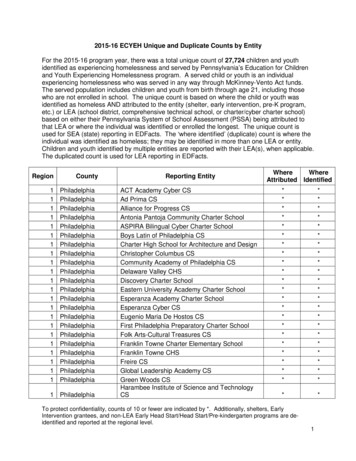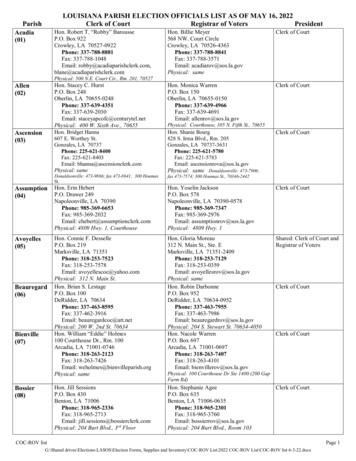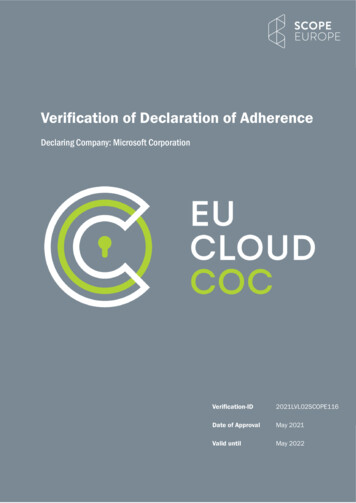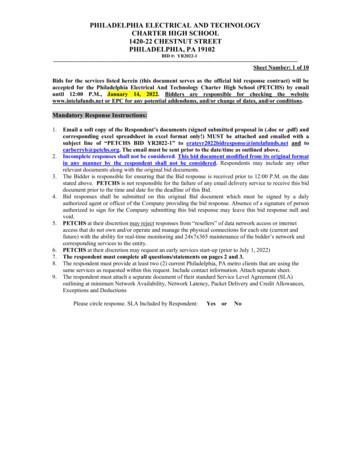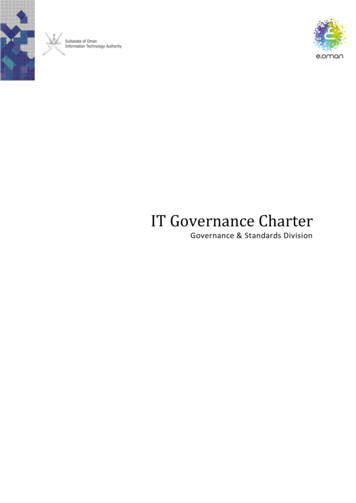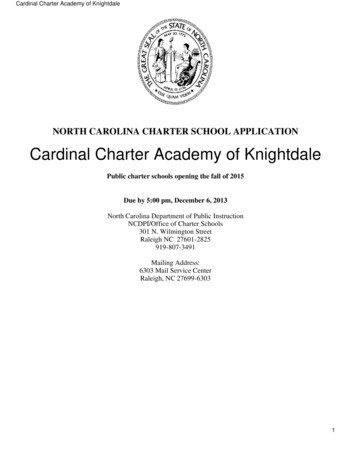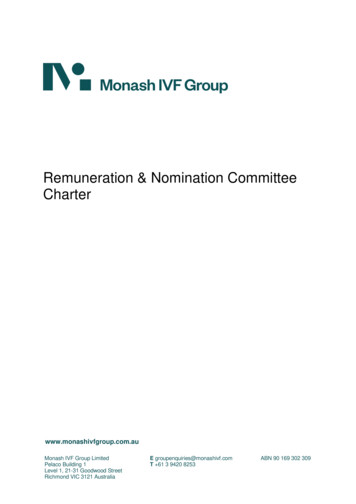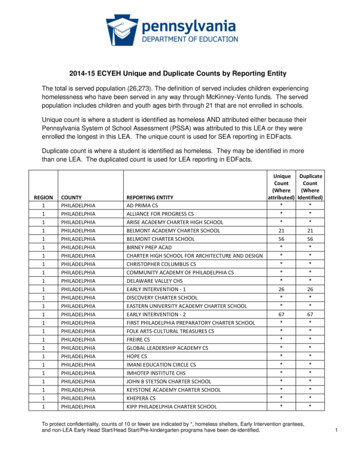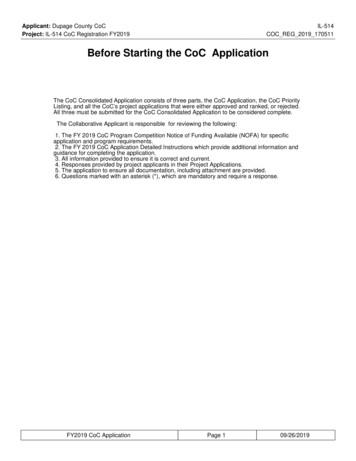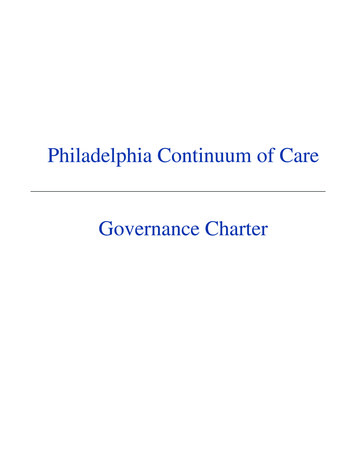
Transcription
Philadelphia Continuum of CareGovernance Charter
Article I.Table of ContentsBackground . 3Purpose of Charter . 3Mission. 3CoC Responsibilities. 3CoC Staffing . 5CoC Membership . 6Full Membership Meetings . 6CoC Governance Structure . 6CoC Board . 6CoC Advisory Committee. 8Standing Subcommittees . 11Workgroups and Ad Hoc Subcommittees. 12Code of Conduct . 12Rules Regarding Conflicts of Interest . 13Rules Regarding Confidentiality. 14Code of Conduct Acknowledgement Form . 14Effective Date . 14Approval of Governance Charter and Subsequent Amendments . 14Philadelphia Continuum of Care Governance Charter2
BackgroundAs stated in the U.S. Department of Housing and Urban Development (HUD) Continuum of CareInterim Rule, a Continuum of Care is designed to address homelessness through a coordinatedcommunity-based process of identifying needs and building a system of housing and services to addressthose needs. At a minimum, the system includes: Outreach, engagement, and assessment;Shelter, housing, and supportive services;Homeless prevention strategiesThe interim rule establishes the Continuum of Care as the planning body responsible for meeting thegoals of the Continuum of Care program. The purpose of the Continuum of Care program is to: Promote a community-wide commitment to the goal of ending homelessness;Provide funding for efforts to quickly re-house individuals (including unaccompanied youth)and families experiencing homelessness while minimizing trauma and dislocation to thosepersons;Promote access to and effective use of mainstream programs by individuals and familiesexperiencing homelessness; andOptimize self-sufficiency among individuals and families experiencing homelessness.Federal Continuum of Care program funds may be used for 1) permanent housing (PH) which includespermanent supportive housing for persons with disabilities (PSH) and rapid re-housing (RRH); 2)transitional housing (TH); 3) Joint Transitional Housing and Permanent Housing – Rapid Re-housingprojects (TH-RRH) to help communities provide crisis housing with financial assistance and wraparound supportive services needed by program participants to quickly move into permanent housing; 4)Supportive Service Only (SSO) projects; and 5) Homeless Management Information System (HMIS).Purpose of CharterThis Charter identifies the purpose, composition, responsibilities, and governance of the PhiladelphiaContinuum of Care (hereinafter referred to as the Philadelphia CoC).MissionThe mission of the Philadelphia CoC is to coordinate and implement a system that prevents anderadicates homelessness throughout Philadelphia, Pennsylvania. It is a broad-based coalition ofhomeless housing and shelter providers, consumers, advocates, government representatives, andcommunity stakeholders working together to shape citywide planning and decision-making.CoC ResponsibilitiesAs established in regulation, the Continuum of Care’s responsibilities include:A. Operating the Continuum of Care1. Hold regular meetings of the full membership, with published agendas, at least semi-annually;2. Make an invitation for new members to join publicly available within the geographic area at leastannually;3. Adopt and follow a written process to select a board to act on behalf of the Continuum of Careand review, update, and approve the process at least once every 5 years;4. Appoint additional committees, subcommittees, or workgroups as needed;5. In consultation with the collaborative applicant and the Homeless Management InformationSystem (HMIS) lead, develop, follow, and update annually (1) a governance charter that includesPhiladelphia Continuum of Care Governance Charter3
6.7.8.9.all procedures and policies needed to comply with 24 CFR Part 578 Subpart B (Establishing andOperating a Continuum of Care) and with HMIS requirements as prescribed by HUD; and (2) acode of conduct and recusal process for the board, its chair(s), and any person acting on behalf ofthe board;Consult with recipients and sub-recipients to establish performance targets appropriate forpopulation and program type, monitor recipient and subrecipient performance, evaluateoutcomes, and take action against poor performers;Evaluate outcomes of projects funded under the Emergency Solutions Grants (ESG) program andthe CoC program, and report to HUD;In consultation with recipients of ESG program funds within the geographic area, establish andoperate either a centralized or coordinated assessment system that provides an initial,comprehensive assessment of the needs of individuals and families for housing and services. TheContinuum must develop a specific policy to guide the operation of the centralized orcoordinated assessment system on how its system will address the needs of individuals andfamilies who are fleeing, or attempting to flee, domestic violence, dating violence, sexual assault,or stalking, but who are seeking shelter or services from nonvictim service providers. Thissystem must comply with any requirements established by HUD by Notice.In consultation with recipients of ESG program funds within the geographic area, establish andconsistently follow written standards for providing CoC assistance. At a minimum, these writtenstandards must include:i.Policies and procedures for evaluating individuals’ and families’ eligibility for assistance;ii. Policies and procedures for determining and prioritizing which eligible individuals andfamilies will receive transitional housing assistance (these policies must include theemergency transfer priority);iii. Policies and procedures for determining and prioritizing which eligible families andindividuals will receive rapid re-housing assistance (these policies must include theemergency transfer priority);iv.Standards for determining what percentage or amount of rent each program participantmust pay while receiving rapid re-housing assistance; andv. Policies and procedures for determining and prioritizing which eligible individuals andfamilies will receive permanent supportive housing (these policies must include theemergency transfer priority).B. Designating a Homeless Management Information System (HMIS) for the Continuum of Care1. Designate a single HMIS for the geographic area;2. Designate an eligible applicant to manage the Continuum’s HMIS, which will be known as theHMIS Lead;3. Review, revise, and approve privacy, security, and data quality plans for the HMIS;4. Ensure consistent participation of recipients and subrecipients in the HMIS; and5. Ensure the HMIS is administered in compliance with requirements prescribed by HUD.C. Continuum of Care Planning1. Coordinate the implementation of a housing and service system within its geographic area thatmeets the needs of the homeless individuals (including unaccompanied youth) and families. At aminimum, such system encompasses the following:i.Outreach, engagement, and assessment;ii. Shelter, housing, and supportive services;iii. Prevention strategiesPhiladelphia Continuum of Care Governance Charter4
2. Plan for and conduct, at least biennially, a Point-in-Time count of homeless persons within thegeographic area that meets the following requirements:3. Homeless persons who are living in a place not designed or ordinarily used as a regular sleepingaccommodation for humans must be counted as unsheltered homeless persons;4. Persons living in emergency shelters and transitional housing projects must be counted assheltered homeless persons;5. Other requirements established by HUD by Notice.6. Conduct an annual gaps analysis of the homelessness needs and services available within thegeographic area;7. Provide information required to complete the Consolidated Plan within the Continuum’sgeographic area;8. Consult with State and local government ESG program recipients within the Continuum’sgeographic area on the plan for allocating ESG funds and reporting on and evaluating theperformance of ESG program recipients and subrecipients.D. VAWA emergency transfer plan. The Continuum of Care must develop the emergency transfer planfor the Continuum of Care that meets the requirements under 24 C.F.R. 578.99(j)(8).E. Preparing an application for funds1. Design, operate, and follow a collaborative process for the development of applications andapprove the submission of applications in response to a NOFA published by HUD;2. Establish priorities for funding projects in the geographic area;3. Determine if one application for funding will be submitted for all projects within the geographicarea or if more than one application will be submitted for the projects within the geographic area;i. If more than one application will be submitted, designate an eligible applicant to bethe collaborative applicant that will collect and combine the required applicationinformation from all applicants and for all projects within the geographic area that theContinuum has selected funding. The collaborative applicant will also apply for Continuumof Care planning activities. If the Continuum is an eligible applicant, it may designateitself;ii. If only one application will be submitted, that applicant will be the collaborativeapplicant and will collect and combine the required application information fromall projects within the geographic area that the Continuum has selected for funding andapply for Continuum of Care planning activities;The Continuum retains all of its responsibilities, even if it designates one or more eligibleapplicants other than itself to apply for funds on behalf of the Continuum. This includesapproving the Continuum of Care application.CoC StaffingThe City of Philadelphia Office of Homeless Services (OHS) is the public entity charged with thepolicy, planning, and coordination of the City’s response to homelessness. Major areas of work includethe coordination of the Homeless Continuum of Care and implementation of strategic plans to reduceand end homelessness.The Office of Homeless Services is the entity responsible for ensuring the Philadelphia CoC fulfills allof the duties of a continuum of care set forth in 24 CFR Part 578 and HMIS requirements as prescribedby the U.S. Department of Housing and Urban Development. Additionally, OHS shall:Philadelphia Continuum of Care Governance Charter5
1. Staff the CoC and related board, committees, workgroups, and ad hoc committees, including butnot limited to:i.Preparing agendas and minutes, meetings materials, and communicationsii.Maintaining records and distribution lists2. Serve as the Collaborative Applicant for CoC program funds3. Serve as the CoC HMIS Lead4. Establish and operate a coordinated assessment systemCoC MembershipMembership in the Philadelphia CoC is open to all stakeholders interested in the purposes of the CoC,including nonprofit homeless assistance providers, victim service providers, faith-based organizations,governments, businesses, advocates, public housing agencies, school districts, social service providers,mental health agencies, hospitals, universities, affordable housing developers, law enforcement, andindividuals currently or formerly experiencing homelessness.Annually, the Office of Homeless Services shall issue a public invitation for any interested person tobecome a member of the CoC. The invitation shall be sent to relevant organizations and posted on theOffice of Homeless Services website. New members may enroll at any time during the year byproviding their name, contact information, and any relevant affiliations to the OHS.All homeless assistance shelter and housing providers in Philadelphia and stakeholders serving on thePhiladelphia CoC Board, CoC Advisory Committee, and CoC Subcommittees are automaticallymembers of the Philadelphia CoC. Voting members are limited to the members of the Philadelphia CoCBoard (hereinafter referred to as the CoC Board).Section 1.01Full Membership MeetingsThe full membership of the Philadelphia CoC shall meet at least semi-annually. The semi-annualmeetings shall include the following:1. A report on the CoC’s activities and progress toward meeting goals2. Any other business the CoC Board and the Office of Homeless Services chooses to put beforethe membersNotice of the date, time, and place of full Membership Meetings shall be sent to members by email atleast fifteen (15) business days before the meeting date.The agenda of full Membership Meetings shall be sent to members by email at least five (5) businessdays before the meeting date.CoC Governance StructureThe Continuum of Care shall have a CoC Board, CoC Advisory Committee, standing Subcommittees,and ad hoc subcommittees and workgroups to accomplish the responsibilities of the CoC, as defined inthe CoC Program interim rule.Section 1.02CoC BoardThe Philadelphia CoC Board is the primary decision making body of the CoC. Decisions shall be madewith input from the CoC Advisory Committee, Subcommittees, and the Office of Homeless Services.ResponsibilitiesThe CoC Board shall be responsible for approval of all CoC policies, procedures, and CoC programfunding decisions.Philadelphia Continuum of Care Governance Charter6
CompositionIn compliance with CoC Program interim rule, the CoC Board must:A. Include at least one individual currently or formerly experiencing homelessnessB. Represent the relevant organizations and projects serving homeless subpopulations, such as personswith substance use disorders; persons with HIV/AIDS; veterans; the chronically homeless; familieswith children; unaccompanied youth; the seriously mentally ill; and victims of domestic violence,dating violence, sexual assault, and stalking.One board member may represent the interests of more than one homeless subpopulation, and the boardmust represent all subpopulations within the CoC to the extent that someone is available and willing torepresent that subpopulation on the board.The Philadelphia CoC Board shall consist of 18 members, of which 15 are voting members and 3 arenon-voting ex-officio members, as follows: Voting Memberso Five (5) government agencies: Department of Behavioral Health and Intellectual disAbility Services (DBHIDS) Division of Housing and Community Development (DHCD) Office of Community Empowerment and Opportunity (City’s Community Action Agency) Philadelphia Housing Authority (PHA) Philadelphia VA Medical Centero Four (4) nonprofit homeless assistance providerso Four (4) individuals currently or formerly experiencing homelessness representing single malesand single females, families, and/or youtho One (1) representative of the Young Adult Leadership Committee, selected by that bodyo Two (2) community stakeholders, e.g business community, hospitals, universities, funders,neighborhood groups/associationsNon-voting Ex-Officio Memberso Office of Homeless Services (OHS)o Chair of the CoC Advisory CommitteeEach organization/agency shall only fill one voting seat.Each voting Board member representing an agency or organization must be an executive or senior levelstaff person.Each organization serving on the Board must have a designated alternate on file with the Office ofHomeless Services. Both are considered CoC Board representatives for their specific seat. The CoCAdvisory Committee Vice-Chair shall serve as the designated alternate for the Advisory CommitteeChair.Selection/Election ProcessFor government representatives, each government agency selects a representative and alternate.For nongovernment representatives, the Office of Homeless Services shall invite CoC members to applyfor CoC Board membership annually. The Nominating Subcommittee shall recommend members to theCoC Board for election to the Board.Term of OfficeGovernment seats are permanent seats dedicated to respective government agencies to encourageinteragency coordination.Philadelphia Continuum of Care Governance Charter7
Board members representing nongovernment entities shall serve staggered terms of three years so thatapproximately one-third of members stand for election each year. In the Board’s first year (Fiscal Year2014-2015), newly-elected members shall draw lots to determine the length of their term—one, two, orthree years. A member may serve two – three year terms. Following the end of a member’s second term,he/she shall not be eligible for re-election until one year has passed.The Chair of the CoC Advisory Committee shall serve on the CoC Board for the duration of his/her twoyear term as Advisory Committee Chair.Resignation and RemovalUnless otherwise provided by written agreement, any representative may resign at any time by givingwritten notice to the Co-Chairs and the Office of Homeless Services. In addition, members may beremoved from the Board by a majority vote of remaining Board members for repeated absence,misconduct, failure to participate, or violation of code of conduct policies.VacanciesWhen a nongovernment representative resigns, is removed from the Board, or cannot serve his/her fullterm for any reason, the Nominating Subcommittee shall call a special election to fill the unexpiredterm. The Nominating Subcommittee shall recommend members to the CoC Board for election to theBoard.OfficersThe CoC Board shall be led by two Co-Chairs, of which one shall represent the Office of HomelessServices.Election and TermThe Co-Chair not representing the Office of Homeless Services shall be elected by the CoC Board. Theex-officio members representing the CoC Advisory Committee and the Young Adult LeadershipCommittee are not eligible for Co-Chair election.The CoC Board Co-Chair not representing the Office of Homeless Services shall serve a two-year term.Following the end of this Co-Chair’s term, he/she shall not be eligible for re-election to the Co-Chairposition until one year has passed.ResponsibilitiesThe Co-Chairs are responsible for the following:1. Call for and preside over Regular and Special meetings.2. Set the CoC Board Meeting agenda, in collaboration with Office of Homeless Services staff.3. Ensure that the CoC Board is working collectively and individually to meet the purposes of thePhiladelphia CoC.ResignationUnless otherwise provided by written agreement, the Co-Chair not representing OHS may resign at anytime by giving written notice to the remaining Co-Chair and the Office of Homeless Services.VacanciesWhen the Co-Chair not representing OHS resigns or cannot serve his/her full term for any reason, theremaining Board members shall call a special election to fill the unexpired term.Philadelphia Continuum of Care Governance Charter8
CoC Board MeetingsA. There will be a minimum of three (3) CoC Board meetings each Philadelphia CoC year.1. The agenda for CoC Board meetings shall be distributed no later than seven (7) business daysprior to the scheduled meeting.2. Minutes of all meetings shall be distributed no later than two (2) weeks following the recordedmeeting.B. Special meetings of the CoC Board may be called by the Co-Chairs when it is deemed in the bestinterest of the Philadelphia CoC, or upon the request of the Office of Homeless Services.C. Voting Procedure:1. Each voting member present, in person or by their designated alternate, shall be entitled to onevote.2. Upon demand of any voting member, any vote shall be by ballot.3. A quorum of more than 50% of the voting members must be present for a motion to be broughtto a vote. If there is no quorum present, the motion is tabled until a time a quorum is present.4. A motion passes if greater than 50% of votes cast are in favor of the motion.5. When time-sensitive issues arise requiring a vote before the next scheduled CoC Board meeting,the CoC Board co-chairs may call for votes to be conducted via email. More than 50% of theCoC Board must vote in favor in order for a motion to pass by email vote.D. The Philadelphia CoC Board will be governed by Roberts Rules of Order.E. 100% attendance is expected. However, in order to be eligible for reelection, a representative, ortheir alternate, must have attended at least 2/3 of the previous year’s CoC Board meetings.Section 1.03CoC Advisory CommitteeResponsibilitiesThe CoC Advisory Committee shall advise and provide input to the Office of Homeless Services and theCoC Board on issues related to the planning and operation of the Philadelphia CoC, including but notlimited to:1. Process for CoC program funding application development and submission, ensuring it is ascompetitive as possible2. Data collection and review of Point-in-Time Count, Housing Inventory Chart, Annual HomelessAssessment Report, and Annual Performance Reports3. Policy and process recommendations made by CoC Standing SubcommitteesThe Advisory Committee shall also provide input to the Office of Homeless Services on broaderimplementation and policy issues impacting homelessness (e.g., emerging trends, service gaps).If applicable, Advisory Committee members shall communicate important Philadelphia CoC activitiesand decisions to their agencies and/or membership.CompositionThe Advisory Committee shall be made up of CoC members interested in the purposes of theCommittee.Each organization’s CoC Advisory Committee member must have a designated alternate on file with theOffice of Homeless Services. Both are considered CoC Advisory Committee representatives for theirspecific seat.Each organization/agency shall only fill one seat.Philadelphia Continuum of Care Governance Charter9
Term of OfficeCoC Advisory Committee members shall serve a one-year term. There is no limit to the number of termsa member may serve.Membership ProcessTo ensure thorough representation by all relevant stakeholders, the Office of Homeless Services shallinvite all CoC members to join the CoC Advisory Committee annually.Resignation and RemovalUnless otherwise provided by written agreement, any representative may resign at any time by givingwritten notice to the Chair and the Office of Homeless Services. In addition, members may be removedfrom the Advisory Committee by a majority vote of remaining Committee members for misconduct orviolation of code of conduct policies.OfficersThe CoC Advisory Committee shall be led by a Chair, who is a non-voting ex-officio member of theCoC Board, and a Vice-Chair.Election and TermThe Chair and Vice-Chair shall be elected by the Advisory Committee. The Chair and Vice Chair shalleach serve 2 year terms. After serving one 2-year term, the Vice-Chair becomes the Committee’s Chair.The Chair shall not be eligible for re-election until one year has passed.ResponsibilitiesThe Chair and Vice-Chair are responsible for the following:1. Call for and preside over Regular and Special meetings.2. Set the Advisory Committee agenda, in collaboration with Office of Homeless Services staff.The Chair represents the Advisory Committee on the CoC Board.ResignationUnless otherwise provided by written agreement, a Chair or Vice-Chair may resign at any time bygiving written notice to the remaining Chair or Vice-Chair.VacanciesWhen the Chair resigns or cannot serve his/her full term for any reason, the Vice-Chair fills theunexpired term.When the Vice-Chair resigns or cannot serve his/her full term for any reason, the remaining Committeemembers shall call a special election to fill the unexpired term.Advisory Committee MeetingsA. The CoC Advisory Committee shall meet quarterly.1. The agenda for Advisory Committee meetings shall be distributed no later than five (5) businessdays prior to the scheduled meeting.2. Minutes of all meetings shall be distributed no later than two (2) weeks following the recordedmeeting.Philadelphia Continuum of Care Governance Charter10
B. Special meetings of the Advisory Committee may be called by the Chair and Vice-Chair when it isdeemed in the best interest of the Philadelphia CoC or upon the request of the Office of HomelessServices.C. 100% attendance is expected. However, in order to be eligible for election to a leadership position onthe CoC Advisory Committee, a representative, or his/her alternate, must have attended at least 2/3of the previous year’s Committee meetings. Also, in order to be eligible to vote for the Chair andVice-Chair, a representative, or their alternate, must have attended at least 2/3 of the previous year’sCommittee meetings.Section 1.04Standing SubcommitteesThe Philadelphia CoC shall have four standing subcommittees, as follows:1. CoC HMIS Subcommittee2. Governance Subcommittee3. Quality Improvement and Evaluation Subcommittee4. Young Adult Leadership CommitteeResponsibilitiesCoC HMIS SubcommitteeAt a minimum, the CoC HMIS Subcommittee shall work with the HMIS Lead to:A. Develop, annually review, and as necessary, make revision recommendations for Philadelphia CoCBoard approval the HMIS Governance Charter, privacy, security, and data quality plans, as well asany other HMIS policies and procedures required by federal partners;B. Develop for Philadelphia CoC Board approval, and implement a plan for monitoring the HMIS toensure that:1. All HMIS Participating Agencies consistently participate in HMIS;2. HMIS is satisfying the requirements of all regulations and notices issued by federal partners;3. The HMIS Lead is fulfilling the obligations outlined in its HMIS Governance Charter andAgreement with the Philadelphia CoC, including the obligation to enter into written participationagreements with each contributing HMIS organization.C. Oversee and monitor HMIS data collection and production of the following reports:1. Sheltered point-in-time count (PIT)2. Housing Inventory Chart (HIC)3. Annual Homeless Assessment Report (AHAR)4. Annual Performance Reports (APRs)5. Data Quality Monitoring ReportsGovernance SubcommitteeAt a minimum, the Governance Subcommittee is responsible for the following:1. Recommend a written process to select a board2. Coordinate CoC Board election processes3. Provide guidance and input to OHS on the development and annual update of the governancecharterQuality Improvement and Evaluation SubcommitteeAt a minimum, the Quality Improvement and Evaluation Subcommittee is responsible for the following:1. Provide guidance and input on a quality improvement processPhiladelphia Continuum of Care Governance Charter11
2. Consult with OHS to establish performance targets appropriate for population and program type3. Evaluate outcomes and recommend actions against poor performers4. Using PIT, HIC, and gap analysis data, recommend funding priorities for annual CoCapplication5. Develop evaluation criteria, measurement tool, and renewal evaluation process for projectapplications6. Recommend and rank programs/projects to include in the annual CoC applicationYoung Adult Leadership CommitteeThe Young Adult Leadership Committee was created in 2016, with the goal of advising the Board andthe Office of Homeless Services on ways to make the system better for youth, and works on goals andprojects around preventing and ending youth homelessness. The Committee is made up of young adultswith experience with homelessness.CompositionStanding Subcommittees shall be made up of CoC members interested in the purposes of the respectivesubcommittee.Term of OfficeStanding Subcommittee members shall serve a one year term. There is no limit to the number of terms amember may serve.Membership ProcessThe Office of Homeless Services shall invite all CoC members to join the Standing Subcommitteesannually.Resignation and RemovalUnless otherwise provided by written agreement, any representative may resign from a Subcommittee atany time by giving written notice to the Office of Homeless Services.OfficersEach Standing Subcommittee shall be led by a Chair who shall serve a one year term. There is no limitto the number of terms a Chair may serve.Section 1.05Workgroups and Ad Hoc SubcommitteesThe Philadelphia CoC may establish workgroups and/or ad hoc subcommittees centered around specificsubpopulations or to accomplish action specific work. These groups may be ongoing or time limited,shall meet as needed, and may include but are not limited to: Children HUD Application Ranking and Chronic HomelessnessReallocation Strategies Coordinated Entry Point-in-Time Count Planning Combined Outreach PSH Policies and Procedures Employment and Income Unaccompanied Youth Families VeteransCode of ConductThe Philadelphia CoC shall adopt a Code of Cond
Philadelphia Continuum of Care Governance Charter 4 all procedures and policies needed to comply with 24 CFR Part 578 Subpart B (Establishing and Operating a Continuum of Care) and with HMIS requirements as prescribed by HUD; and (2) a code of conduct and recusal process for the board, its chair(s), and any person acting on behalf of the board;
